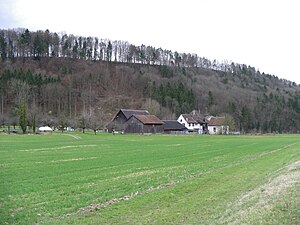Wonder blades
Wunderklingen ( al. Wonderchlinge ) is a hamlet in the municipality of Hallau in the canton of Schaffhausen. The hamlet is located in the west of the municipality on the Wutach and at the same time on the border between Switzerland and Germany at about 420 m above sea level. M.
history
Early history
When excavations for spring water were carried out in Wunderklingen in 1895, Roman foundations were found immediately north of the hamlet in the “Lochgrabe” , which were excavated by the historical-antiquarian association of the canton of Schaffhausen. Several walls and a stone cellar were excavated (see adjacent plan). Some of the finds made such as tegulae , hollow bricks (tubuli), plastering, terra sigillata , iron objects and bones are exhibited today in the Hallau local museum and in the All Saints Museum in Schaffhausen, while other finds are kept at the Schaffhausen Cantonal Archeology.
middle Ages
Wundklingen was first mentioned in a document in 892, when Guathere transferred its property in "Mundichingen" to the Rheinau monastery . Miracle blades were mentioned again as early as 912, this time when King Konrad donated "Münchingen" to the St. Gallen monastery . A document in the General State Archives in Karlsruhe dated September 19, 1397 testifies to the presence of a chapel in miracle blades, which is no longer there today. This is not surprising: Wundklingen is an Alemannic settlement from the 6th / 7th centuries. Century, formed its own village community and had three tents under the parish ban . In 1457, the community of Hallau then bought the ban district and the jurisdiction for 400 guilders from Junker Heinrich von Erzingen .
The mill
The Hallau residents probably built a mill on the Wutach shortly after the purchase . At that time there was already a mill in the spell of Wunderklingen, the Lochgrabenmühle, which probably perished during the Thirty Years' War . A few years later the mill was moved back on the Wutach and a weir and a canal were built. When it rains heavily, it was not uncommon for the weir to be washed away and the citizens of Hallau to have to rebuild the weir by labor. Between 1546 and 1843 this was the case about 50 times. In 1821 the mill was in such poor condition that it had to be rebuilt. But the mill became less and less profitable, so it was sold in 1876. Today there is an inn in the former mill. The Reuentaler Mühle is located at Ofteringen, downstream from Wunderklingen .
Hallau water and electricity works (WEH)
In 1895 the people of Hallau bought the mill back to build a water and electricity works. The above-mentioned Roman foundations were discovered during its construction. The electricity is produced with hydropower from the former mill canal. The facility was inaugurated on July 13, 1896. In 1968 the old machines had to be replaced and a new building was built that is still in operation today. It supplies the community of Hallau with water and partly with electricity.
literature
- Jakob Pfund: Historical facts about the Wunderklingen farm near Unter-Hallau . Hallau 1926.
- Robert Pfund: The court miracle blades . In: History of Hallau . Hallau 1991, pp. 350-359.
- Roland Cadario: The Hallau water and electricity company (WEH) . In: History of Hallau . Hallau 1991, pp. 216-227.
- Heinz Buri, Alex Wildberger: Water and electricity works of the Hallau community . Hallau 1969.
Web links
Individual evidence
- ↑ Jürgen Trumm: The Roman settlement on the eastern Upper Rhine. Stuttgart 2002, ISBN 3-8062-1643-6 .
- ^ Adrian Bringolf: The early historical finds of the community Hallau. Hallau 2010.
- ↑ J. Escher, P. Schweizer: Document book of the city and landscape of Zurich , Bd. 1, Zurich 1888.
- ^ Hermann Wartmann: Document book of the Abbey of Sanct Gallen. Zurich 1866.
- ^ History of Hallau . Hallau 1991, p. 45.
- ^ History of Hallau . Hallau 1991, p. 357.
- ↑ Heinz Buri, Alex Wildberger: Water and electricity works of the community Hallau . Hallau 1969.
- ^ History of Hallau . Hallau 1991, pp. 216-227.
Coordinates: 47 ° 41 ′ 53 " N , 8 ° 24 ′ 24" E ; CH1903: 672,667 / 283497



